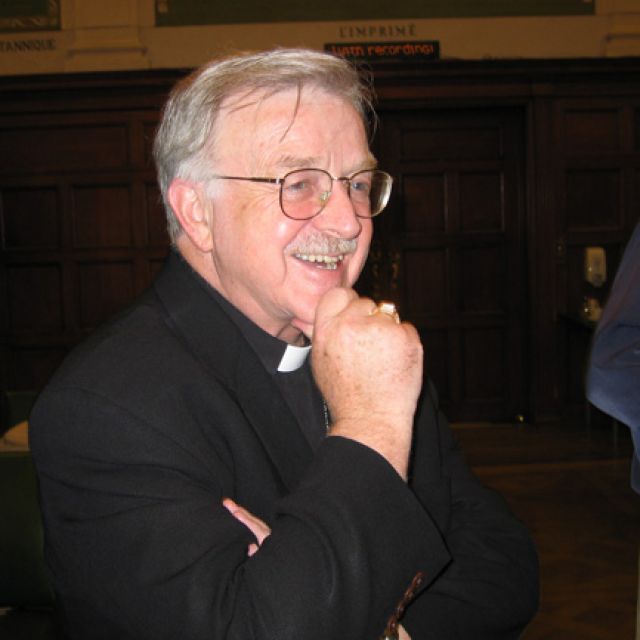It’s quite similar to what Catholics would be used to — after all, it’s a Catholic Mass approved by the Holy See for former Anglicans. The language draws upon the distinctive sacral style of the Anglican tradition and the liturgical rubrics are similar to the “extraordinary form” or Tridentine Mass. So there are “vouchsafes” and “wherefores” offered on behalf of “servants and handmaids” who have “erred and strayed like lost sheep who have followed too much the devices” of their own hearts. For those with an ear for the glories of the English language, it is all really quite splendid.
Upon reception into the Catholic Church, Fr. Kenyon became a Catholic layman. On an accelerated program of formation, he expects to be ordained a Catholic priest some time this year. In the meantime, other priests are required to offer the Anglican Use Mass for them. While Fr. Michael Storey, a priest of the Calgary diocese, has been doing so, St. John’s was kind enough to invite me to do so for them last week.
It was a blessing, not only to experience something of the beauty of the Anglican tradition, but also to touch what Christian unity is in the tangible reality of the sacraments. St. John’s is small to be sure, but the full communion they enjoy is a real fruit of the Holy Father’s initiative in 2009, Anglicanorum coetibus.
In that apostolic constitution, Benedict XVI provided measures by which groups of former Anglicans could come into communion with the Catholic Church while maintaining their own patrimony in a specially constituted “ordinariate” — or a non-territorial diocese. It was a delicate matter to be sure, and the archbishop of Canterbury was broad-minded and cordial in his reception of the plan, aimed at those Anglicans who had expressed a desire to become Roman Catholic. It was most generous treatment for a group of people who, worldwide, would hardly amount to the population of single parish in Manila or Guadalajara.
It is not really a question of numbers though. The more important question is whether the incorporation of former Anglicans will be an evangelical project or a mere cultural one. Providing a way for Catholics to be exquisitely English may be noble in its own way, but Englishness is a linguistic, literary and cultural category, not an evangelical one. The mission must be to put the riches of a distinctive culture at the service of proclaiming the Gospel, not the other way around.
Fr. Kenyon understands this fully, saying that he has no interest in St. John’s providing “boutique religion.” He knows that they will not be “big box religion” either, but he wants St. John’s to be a parish in the mainstream of the new evangelization. So this is not about something old getting a dignified decline into old age and eventually a decent burial. It’s about a particular tradition becoming vibrant again and helping to bring new life to the great Christian tradition.
In the sacristy before Mass, Fr. Kenyon was instructing me in the ways of the Anglican Use and, amused by my commenting upon one or another usage, explained wryly, “Our Mass has been 500 years in the making.”
That’s important in an era marked by much liturgical change and confusion. Yet as Fr. Kenyon knows only too well, a Mass 500 years old is only about a quarter as old as it ought to be. The Mass now offered at St. John’s is a full 2,000 years old, with the adornment of venerable half-century-old accents. Soon the former and future Fr. Kenyon will offer a properly aged Mass in his own right, bringing with his congregation fresh energies to the new evangelization.
Fresh energy for the Church, 500 years in the making
By Fr. Raymond J. de SouzaCALGARY - Inglewood is an old neighbourhood in Calgary, the sort of place where you find a church nestled between modest homes, rather than surrounded by a vast suburban parking lot. But something new is happening here, or something old becoming something new — or perhaps even something new becoming something old.
The parish of St. John the Evangelist used to be an Anglican parish, but just a week before Christmas the pastor, Fr. Lee Kenyon, his wife Elizabeth, and almost the entire congregation of about 75 souls were received into full communion with the Catholic Church. Bishop Frederick Henry of Calgary received the group and graciously welcomed into his diocese a new parish. They call themselves an “Anglican Use” oparish, meaning that while fully Catholic and in communion with the bishop of Rome, they use a form of the liturgy more in keeping with their Anglican traditions.
Please support The Catholic Register
Unlike many media companies, The Catholic Register has never charged readers for access to the news and information on our website. We want to keep our award-winning journalism as widely available as possible. But we need your help.
For more than 125 years, The Register has been a trusted source of faith-based journalism. By making even a small donation you help ensure our future as an important voice in the Catholic Church. If you support the mission of Catholic journalism, please donate today. Thank you.
DONATE

